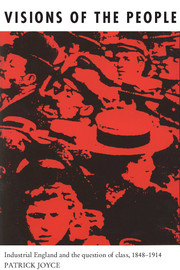Book contents
- Frontmatter
- Contents
- List of plates
- Acknowledgements
- 1 Introduction: beyond class?
- PART I POWER AND THE PEOPLE: POLITICS AND THE SOCIAL ORDER
- PART II MORALISING THE MARKET: WORK AND THE SOCIAL ORDER
- PART III CUSTOM, HISTORY, LANGUAGE: POPULAR CULTURE AND THE SOCIAL ORDER
- 6 Custom and the symbolic structure of the social order
- 7 The sense of the past
- 8 The people's English
- PART IV KINGDOMS OF THE MIND: THE IMAGINARY CONSTITUTION OF THE SOCIAL ORDER
- Appendices
- Bibliographical note
- Notes
- Index
8 - The people's English
Published online by Cambridge University Press: 05 March 2012
- Frontmatter
- Contents
- List of plates
- Acknowledgements
- 1 Introduction: beyond class?
- PART I POWER AND THE PEOPLE: POLITICS AND THE SOCIAL ORDER
- PART II MORALISING THE MARKET: WORK AND THE SOCIAL ORDER
- PART III CUSTOM, HISTORY, LANGUAGE: POPULAR CULTURE AND THE SOCIAL ORDER
- 6 Custom and the symbolic structure of the social order
- 7 The sense of the past
- 8 The people's English
- PART IV KINGDOMS OF THE MIND: THE IMAGINARY CONSTITUTION OF THE SOCIAL ORDER
- Appendices
- Bibliographical note
- Notes
- Index
Summary
Understanding language helps us understand culture and the representations of the social order evident in culture. Language will be approached here in two senses; actual spoken language – use and attitudes to this use – and more generalised notions of what language was and what it stood for. The two senses of course overlapped, attitudes to use evident for example in schoolbooks or manuals of language use being influenced by theories of language which were part of the general intellectual climate. Nonetheless, the distinction is a useful one, for it corresponds both to the sense of culture as a way of life and everyday social practice, and to culture in the sense of ideology. In the conditions of the period, ideas about language and culture were in fact almost interchangeable. Understandings of the social order also correspond to these two senses of language and culture: language use takes us to the heart of social identity, and ideas about language and culture were pregnant with ideas about society.
Let me begin with language use, and Shaw: ‘It is impossible for an Englishman to open his mouth without making some other Englishman hate or despise him.’ The acute sensitivity of the English to the linguistic markers of class has long been noted. Playwrights and novelists are one guide to this: writing in the same Edwardian period as Shaw, Wells' novels offer much insight into sensitivities that had by then become almost morbid. Contemporary sociolinguistics offers another guide, one not usually enlisted by historians.
- Type
- Chapter
- Information
- Visions of the PeopleIndustrial England and the Question of Class, c.1848–1914, pp. 193 - 212Publisher: Cambridge University PressPrint publication year: 1991
- 1
- Cited by



